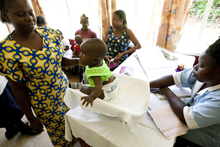
Asking Smart Questions: Where Are Health Workers within Service Integration?
 President Obama’s Global Health Initiative (GHI) argues that its intended health impacts will be accomplished most effectively through a “smart” integration of services.
President Obama’s Global Health Initiative (GHI) argues that its intended health impacts will be accomplished most effectively through a “smart” integration of services.
In an effort to share the empirical evidence demonstrating different service integration models’ effects on health outcomes, the US Government recently hosted a two-day meeting that brought together researchers, host country and international implementing partners, advocates, and US Government program leaders.
This forum provided many opportunities to discuss what is known about the health workforce as a critical system component of service integration.
Lack of evidence
During this meeting, the Cochrane HIV/AIDS Group shared its findings from an exhaustive review of all published work on the integration of maternal and child health, family planning, and HIV/AIDS services.
- Out of almost 8,000 unduplicated citations that met the initial search criteria, only 20 articles representing 19 integration interventions made it through the screening process that evaluated the rigor of the studies’ designs.
- Among the 20 published articles, none included a randomized trial and only one applied a cluster randomized trial (a step-wedge design).The other studies used less rigorous design protocols.
- The review underscored the lack of empirical evidence concerning the impact of integration on existing services and health outcomes, as well as the virtual absence of cost or cost-effectiveness data.
With so few rigorous study designs and insufficient data, the scant attention paid to the inputs of service delivery, regardless of the implementation model, is self-evident. These critical inputs include—among others—several of the key components of health systems: information, commodities and equipment, and health workers. Health workers
Health workers
In particular, I was struck by the extent to which the health worker as input or output in the evaluation of service integration models is conceptually absent. While many of the meeting’s presenters observed that a major constraint in successful service integration was health worker overload or turnover, none of the studies they presented had systematically assessed the baseline values for health worker scope of practice (e.g., workload) or retention at facilities.
It is entirely possible that in any particular program or context, service integration may increase, decrease, or have little effect on health worker productivity, retention, and/or the quality of care offered. We just don’t know, because we’re not asking the questions.
Leveraging the GHI’s learning agenda
However, it became clear to me that new opportunities exist under the GHI to ask—and answer—these questions. Senior Advisor for Child Health and Pediatric AIDS in USAID’s Global Health Bureau Dr. Troy Jacobs focused his discussion on the topic of improving health efficiencies. He suggested that we must be able to answer the following question in monitoring the GHI’s integration principle: Is this [integration approach] the “right fix in the right place at the right time?”
To do so requires answering the parallel question from the health workforce perspective: Do we have the right combination of skilled health workers in the right place at the right time? We won’t know the answer to this health workforce question at the end of the GHI unless we know where we are at the beginning. Now is the time to start asking.
Related items:
Photo 1 by Jennifer Solomon. Photo 2 by Trevor Snapp. (Weighing a baby at Friends Kaimosi Hospital, Kenya)


